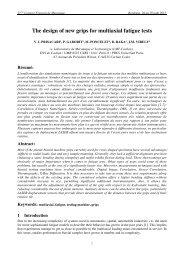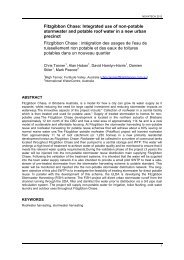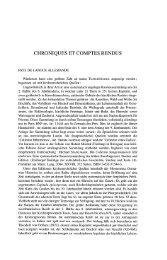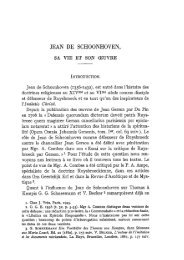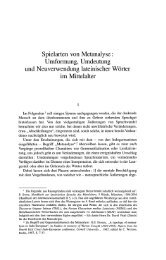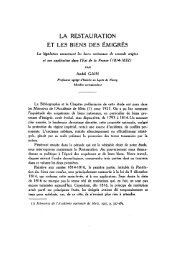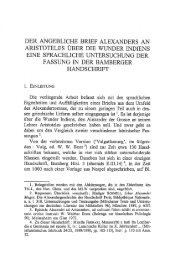Stratégie thérapeutique chez les patients atteints du ... - I-Revues
Stratégie thérapeutique chez les patients atteints du ... - I-Revues
Stratégie thérapeutique chez les patients atteints du ... - I-Revues
Create successful ePaper yourself
Turn your PDF publications into a flip-book with our unique Google optimized e-Paper software.
<strong>Stratégie</strong> <strong>thérapeutique</strong> <strong>chez</strong> <strong>les</strong> <strong>patients</strong> <strong>atteints</strong><br />
<strong>du</strong> syndrome de l’intestin irritable<br />
M. DELVAUX, G. GAY<br />
Department of Internal Medicine and Digestive Pathology, Hôpitaux de Brabois, CHU de Nancy (France)<br />
Therapeutic strategy in <strong>patients</strong> with irritable bowel syndrome<br />
RÉSUMÉ<br />
La prise en charge <strong>du</strong> syndrome de l’intestin irritable doit tenir compte de sa physiopathologie multifactorielle et de l’expression<br />
clinique très variable de l’affection dans le temps <strong>chez</strong> chaque patient ainsi que de l’existence de sous-groupes de <strong>patients</strong>, principalement<br />
caractérisés par la nature des troub<strong>les</strong> <strong>du</strong> transit qu’ils présentent.<br />
Les antispasmodiques, éventuellement associés à des médicaments corrigeant <strong>les</strong> troub<strong>les</strong> <strong>du</strong> transit — laxatifs et antidiarrhéiques —<br />
constituent aujourd’hui la première ligne de traitements. Certains antidépresseurs à faible dose ont une activité spécifique sur la fonction<br />
sensori-motrice <strong>du</strong> tractus digestif et peuvent être utilisés en seconde intention.<br />
Les nouveaux traitements, non encore disponib<strong>les</strong> en Europe, agissent sur <strong>les</strong> récepteurs de la sérotonine, <strong>les</strong> antagonistes des<br />
récepteurs 5-HT 3 pour freiner le transit <strong>chez</strong> <strong>les</strong> <strong>patients</strong> avec un syndrome de l’intestin irritable à forme diarrhéique et <strong>les</strong> agonistes des<br />
récepteurs 5-HT 4 pour accélérer le transit <strong>chez</strong> <strong>les</strong> <strong>patients</strong> avec un syndrome de l’intestin irritable à prédominance de constipation.<br />
L’utilisation d’autres formes de traitement, notamment la psychothérapie de soutien doit également être envisagée, plutôt en seconde<br />
intention, après un diagnostic précis tant gastro-entérologique que psychiatrique.<br />
SUMMARY<br />
The management of <strong>patients</strong> with irritable bowel syndrome must take into account its multifactorial pathophysiology and the dramatically<br />
variable clinical expression of the syndrome between <strong>patients</strong> and over time in one patient as well as the need to adapt therapy to existing<br />
subgroups of <strong>patients</strong>, mainly characterized by their bowel habit disturbances.<br />
Antispasmodics, associated when needed with treatments alleviating bowel disturbances, i.e. laxatives and antidiarrheal agents, are the<br />
first line of treatment. Some antidepressants used at low doses alter the sensorimotor function of the gut and can be used as second line.<br />
New treatments, not yet available in Europe, act on serotoninergic receptors: antagonists at the 5-HT 3 receptor delay transit time and are<br />
indicated in patient with diarrhea predominant IBS; agonists at the 5-HT 4 receptor accelerate transit and are to be used in <strong>patients</strong> with<br />
constipation-prone IBS.<br />
Other treatments, including cognitive and behavioral psychotherapy, can be used in refractory <strong>patients</strong>, after a precise gastroenterological<br />
and psychiatric diagnosis.<br />
INTRODUCTION<br />
Le syndrome de l’intestin irritable (SII) touche jusqu’à<br />
20 % de la population a<strong>du</strong>lte dans <strong>les</strong> pays occidentaux.<br />
Le SII est une affection chronique à l’origine<br />
de nombreuses consultations et qui représente<br />
un coût de santé publique assez considérable [1, 2].<br />
En général, <strong>les</strong> <strong>patients</strong> consultent en premier lieu<br />
leur médecin traitant qui <strong>les</strong> adresse ensuite au spécialiste<br />
en raison d’une incertitude diagnostique ou<br />
d’une insatisfaction <strong>du</strong> patient [3]. Bien qu’ils ne<br />
représentent que 20 % de toute la population souffrant<br />
de SII, <strong>les</strong> <strong>patients</strong> adressés à un spécialiste<br />
génèrent des coûts de santé plus élevés avec à l’issue<br />
<strong>du</strong> traitement, un résultat souvent considéré comme<br />
médiocre à la fois par le patient et le médecin.<br />
De ce fait, le traitement <strong>du</strong> SII reste un défi à la fois<br />
pour le médecin traitant et pour le gastroentérologue.<br />
Il doit être approprié en fonction de chaque patient et<br />
de l’impact de la symptomatologie sur la qualité de<br />
vie (Tableau I). L’approche clinique est fondée sur<br />
un questionnaire précis visant à obtenir un diagnostic<br />
positif tenant compte de l’agenda <strong>du</strong> patient pour<br />
obtenir une réponse <strong>thérapeutique</strong> progressive. Le<br />
but de cette revue est de décrire l’arsenal <strong>thérapeutique</strong><br />
actuellement disponible pour le traitement des<br />
Tirés à part : D r Michel DELVAUX, Department of Internal Medicine and Digestive Pathology, Hôpitaux de Brabois, CHU de Nancy -<br />
F-54511 Vandœuvre-lès-Nancy (France).<br />
Mots-clés : SII traitements.<br />
Key-words : IBS therapeutics.<br />
Acta Endoscopica Volume 35 - N° 4- 2005 649
<strong>patients</strong> avec syndrome de l’intestin irritable et d’en<br />
évaluer l’efficacité clinique de manière à proposer<br />
une stratégie pour une approche globale étape par<br />
étape.<br />
650<br />
T ABLEAU I<br />
PRÉSENTATION CLINIQUE DES PATIENTS AVEC SII :<br />
SÉVÉRITÉ DES SYMPTÔMES ET COMORBIDITÉ<br />
Faible Modérée Sévère<br />
Prévalence estimée 70 % 25 % 5 %<br />
Prise en charge Primaire Secondaire Tertiaire<br />
Corrélation physiologique +++ ++ +<br />
Constance des symptômes 0 + +++<br />
Interruption d’activité 0 + +++<br />
Recours aux soins + ++ +++<br />
Comportement hypocondriaque 0 + +++<br />
Diagnostic psychiatrique 0 + +++<br />
Repro<strong>du</strong>ction autorisée d’après Drossman et Thompson [4].<br />
BASES PHYSIOPATHOLOGIQUES<br />
DES TRAITEMENTS DU SII<br />
Parmi <strong>les</strong> progrès récents dans la compréhension<br />
de la physiopathologie <strong>du</strong> SII, notons la mise en évidence<br />
<strong>du</strong> rôle des afférences nerveuses d’origine<br />
digestive, impliquées dans l’hypersensibilité viscérale<br />
Début d e v ie<br />
F acteurs g énétiq ues<br />
Environnement<br />
Repro<strong>du</strong>it d’après Drossman [6].<br />
Facteurs psycho-sociaux<br />
Evénements traumatisants<br />
Adaptabilité<br />
Support social<br />
A xe cerv eau-in testin<br />
Fon ction s d i g estiv es<br />
M otilité<br />
Sensation<br />
souvent présente <strong>chez</strong> ces <strong>patients</strong> [5]. Cette découverte<br />
a permis de porter un éclairage nouveau sur le<br />
rôle de l’ «axe cerveau-intestin » qui relie <strong>les</strong> systèmes<br />
nerveux centraux et entériques par des voies<br />
nerveuses complexes. Autour de cet axe cerveauintestin,<br />
tous <strong>les</strong> facteurs physiopathologiques <strong>du</strong> SII<br />
ont pu être organisés dans un modèle global proposé<br />
par Drossman [6] et représenté à la Figure 1.<br />
L’axe cerveau-intestin est constitué de deux<br />
composantes majeures : <strong>les</strong> afférences qui véhiculent<br />
<strong>les</strong> informations de l’intestin vers le cerveau et <strong>les</strong><br />
voies nerveuses efférentes qui contrôlent <strong>les</strong> diverses<br />
fonctions digestives : sécrétions, motricité, sensibilité<br />
et réflexes. Les altérations au niveau de la fonction<br />
sensitive sont liées aux voies nerveuses afférentes et<br />
sont responsab<strong>les</strong> d’une hypersensibilité viscérale<br />
caractérisée par des seuils de sensibilité diminués au<br />
cours des études de distension effectués <strong>chez</strong> des<br />
<strong>patients</strong> avec SII, comparés à un groupe témoin [7-10].<br />
L’hypersensibilité viscérale est décrite <strong>chez</strong> <strong>les</strong> 2/3<br />
des <strong>patients</strong> avec SII et <strong>les</strong> récepteurs des neurotransmetteurs<br />
impliqués dans le fonctionnement des nerfs<br />
digestifs afférents sont des cib<strong>les</strong> pour le traitement<br />
pharmacologique <strong>du</strong> SII [11]. D’autre part, plusieurs<br />
études ont suggéré l’implication des troub<strong>les</strong> de la<br />
motricité intestinale <strong>chez</strong> <strong>les</strong> <strong>patients</strong> avec SII.<br />
Cependant, ces perturbations de la motricité intestinale<br />
ou colique sont loin d’être spécifiques <strong>du</strong> SII car<br />
une activité motrice similaire peut être retrouvée<br />
<strong>chez</strong> des sujets sains [12]. Les modifications de<br />
la motricité intestinale semblent être davantage<br />
Volume 35 - N° 4- 2005 Acta Endoscopica<br />
TIB<br />
S y mptô mes<br />
C omportement<br />
Figure 1<br />
Modèle pathophysiologique <strong>du</strong> syndrome <strong>du</strong> côlon irritable.<br />
R é sul tats<br />
T raitement<br />
C onsultation<br />
V ie q uotidienne<br />
Q ualité de vie
corrélés aux troub<strong>les</strong> <strong>du</strong> transit associés au SII, tels<br />
que la constipation, la diarrhée ou l’alternance des<br />
deux qu’aux douleurs. Néanmoins, on était en droit<br />
d’attendre des médicaments régulateurs de la motricité<br />
digestive, une amélioration <strong>chez</strong> ces <strong>patients</strong> ce<br />
qui a con<strong>du</strong>it à l’administration d’antispasmodiques.<br />
D’autre part, plusieurs études ont permis de reconnaître<br />
l’importance des facteurs psycho-sociaux et<br />
d’événements dans la vie <strong>du</strong> patient tels que le stress<br />
psychologique qui exacerbent <strong>les</strong> symptômes gastrointestinaux.<br />
Les troub<strong>les</strong> psychologiques et d’autres<br />
syndromes douloureux chroniques souvent associés<br />
au SII avec une diminution significative de la qualité<br />
de vie <strong>chez</strong> ces <strong>patients</strong> [13, 14]. En complément ou<br />
comme alternative au traitement pharmacologique,<br />
des anti-dépresseurs et une psychothérapie ont été<br />
proposés à ces <strong>patients</strong> de manière à <strong>les</strong> aider à mieux<br />
contrôler leurs symptômes et <strong>les</strong> conséquences de<br />
ceux-ci dans leur vie quotidienne.<br />
BASES PHARMACOLOGIQUES<br />
DU TRAITEMENT DU SII<br />
Une étude de la littérature montre que de nombreux<br />
médicaments ont été proposés pour le traitement<br />
des <strong>patients</strong> <strong>atteints</strong> de SII. A titre d’exemple,<br />
le tableau II présente une liste de médicaments<br />
agréés dans divers pays européens et qu’il est possible<br />
de proposer à ces <strong>patients</strong>. Les plus populaires sont<br />
<strong>les</strong> antispasmodiques ou <strong>les</strong> relaxants <strong>du</strong> muscle lisse<br />
classés comme atropiniques ou non atropiniques, en<br />
fonction de leur action sur le récepteur muscarinique.<br />
La littérature récente a montré que ces classes médicamenteuses<br />
ont des propriétés pharmacologiques<br />
multip<strong>les</strong> et constituent un groupe de substances très<br />
hétérogènes. De plus, des études <strong>chez</strong> l’homme et<br />
l’animal ont démontré l’effet de ces «antispasmodiques<br />
» sur la motricité et la sensibilité, effets qui<br />
pourraient présenter un intérêt dans le traitement <strong>du</strong><br />
SII (Tableau III).<br />
Associés aux relaxants <strong>du</strong> muscle lisse qui à l’origine,<br />
sont destinés à soulager la douleur abdominale<br />
et le ballonnement, des laxatifs, des anti-diarrhéiques<br />
ou des adsorbants tels que <strong>les</strong> dérivés d’argile sont<br />
souvent prescrits. La description de leur effet clinique,<br />
bien connu des médecins et de leurs <strong>patients</strong><br />
dépasserait le cadre de cette revue. D’autres traitements<br />
ont également été proposés, souvent de façon<br />
empirique mais <strong>les</strong> essais cliniques n’ont pas clairement<br />
démontré leur efficacité : adsorbants intestinaux,<br />
dérivés <strong>du</strong> charbon qui sont fréquemment prescrits<br />
en association avec <strong>les</strong> antispasmodiques [2].<br />
EFFICACITÉ CLINIQUE<br />
DES TRAITEMENTS PHARMACOLOGIQUES<br />
CHEZ LES PATIENTS AVEC SII<br />
Effet clinique des antispasmodiques<br />
L’évaluation <strong>du</strong> bénéfice clinique des médicaments<br />
visant à soulager <strong>les</strong> douleurs abdomina<strong>les</strong> des<br />
1. Médications agissant sur le muscle lisse (régulateurs<br />
de la motricité)<br />
Atropiniques Antispasmodiques<br />
Atropine<br />
Hyosciamine<br />
Tiemonium<br />
Antispasmodiques non-atropiniques<br />
Bromure de Pinaverium<br />
Phloroglucinol<br />
Citrate d’Alvérine<br />
Fenovérine<br />
Régulateurs <strong>du</strong> muscle lisse<br />
Trimébutine<br />
Mébévérine<br />
Bromure de Pinaverium<br />
Citrate d’Alvérine<br />
Prokinétiques<br />
Métoclopramide<br />
Dompéridone<br />
Cisapride<br />
2. Autres traitements digestifs<br />
Laxatifs<br />
Antidiarrhéïques<br />
Adsorbants intestinaux<br />
Dérivés <strong>du</strong> charbon<br />
Antiacides<br />
Médicaments antisécrétoires<br />
Extraits pancréatiques<br />
3. Médicaments psychotropes<br />
Anxiolytiques<br />
Antidépresseurs<br />
Amitryptiline<br />
Imipramine<br />
Fluoxétine<br />
T ABLEAU II<br />
CLASSES PHARMACOLOGIQUES POUVANT ÊTRE<br />
PRESCRITES DANS LE TRAITEMENT<br />
DES TROUBLES FONCTIONNELS DE L’INTESTIN<br />
DANS DE NOMBREUX PAYS EUROPÉENS<br />
<strong>patients</strong> avec SII s’est avérée difficile en raison d’un<br />
taux élevé de répondeurs au placebo. De plus, l’évaluation<br />
scientifique des effets pharmacodynamiques<br />
et cliniques de ces médicaments a été remise en cause<br />
dans la littérature scientifique récente. En fait, dans<br />
une large revue reprenant toutes <strong>les</strong> études publiées<br />
avant 1988, Klein a démontré qu’aucune des études<br />
considérées n’avait une qualité méthodologique suffisante<br />
pour permettre une conclusion valide quant à<br />
l’efficacité des antispasmodiques dans le traitement<br />
<strong>du</strong> SII [15]. Certains auteurs, cependant, ne partageaient<br />
pas cet avis. Dans une méta-analyse évaluant<br />
des relaxants <strong>du</strong> muscle lisse dans le traitement <strong>du</strong><br />
SII, Poynard et al. ont pu démontrer un effet significatif<br />
de ces molécu<strong>les</strong> sur un large spectre de symptômes<br />
[16]. Cette méta analyse a conclu à l’efficacité<br />
de 5 médicaments pour soulager la douleur abdominale<br />
<strong>du</strong> SII (64 % d’amélioration contre 45 % pour le<br />
placebo ; p
significative n’a pu être démontrée avec ces médicaments<br />
pour la constipation ou le ballonnement intestinal.<br />
Les 5 médicaments reconnus efficaces dans<br />
cette méta analyse étaient : le bromure de cimétropium,<br />
le bromure de pinaverium, la trimébutine, le<br />
bromure d’otilinium et la mébévérine.<br />
Plus récemment, <strong>les</strong> résultats de cette méta analyse<br />
ont été confirmés par une seconde analyse [17]<br />
concluant également au bénéfice clinique apporté par<br />
<strong>les</strong> antispasmodiques sur la douleur abdominale.<br />
Dans une nouvelle méta-analyse mesurant le bénéfice<br />
clinique en terme d’ «amélioration globale »<br />
comme cela a été fait récemment lors d’essais cliniques<br />
visant à démontrer l’effet des agents sérotoninergiques,<br />
Poynard et al. ont confirmé ce bénéfice des<br />
antispasmodiques <strong>chez</strong> <strong>les</strong> <strong>patients</strong> avec SII [18]. Ils<br />
ont conclu à la supériorité des antispasmodiques pour<br />
procurer une amélioration globale <strong>chez</strong> 56 % des<br />
<strong>patients</strong>, contre 38 % pour le placebo (p < 0.001). Il<br />
est intéressant de constater que l’amplitude de l’effet<br />
mesuré par rapport au placebo était semblable à celle<br />
de l’effet des agents sérotoninergiques récemment<br />
mis sur le marché [19, 20].<br />
Les antispasmodiques sont largement prescrits aux<br />
<strong>patients</strong> <strong>atteints</strong> de SII, soit en traitement court<br />
<strong>du</strong>rant <strong>les</strong> épisodes douloureux ou en traitement long<br />
ou traitement d’entretien visant à prévenir de nouvel<strong>les</strong><br />
poussées douloureuses [2]. Nous avons réalisé<br />
une étude linéaire avec la mébévérine, administrée<br />
oralement (200 mg/jour) à des <strong>patients</strong> avec SII [9].<br />
Dans cette étude, nous avons eu la surprise de constater<br />
que la mébévérine diminuait de façon significative<br />
l’intensité de la douleur abdominale sur toute la<br />
période de traitement. Cependant, parallèlement, <strong>les</strong><br />
<strong>patients</strong> se plaignaient davantage de ballonnement.<br />
Dans une large enquête incluant 1302 <strong>patients</strong><br />
<strong>atteints</strong> de SII, réalisée en France en 1992, <strong>les</strong> médicaments<br />
<strong>les</strong> plus prescrits pour le SII ont pu être analysés<br />
[2]. Cette étude comprenait un suivi de 9 mois<br />
652<br />
T ABLEAU III<br />
EFFETS PHARMACOLOGIQUES ET PHARMACODYNAMIQUES DES ANTISPASMODIQUES<br />
Nom (ICD) Cible Pharmacologique Effet sur la motricité digestive Effet sur la sensibilité digestive<br />
Citrate d’Alvérine 3 × 60 mg Antagoniste 5-HT1A (42) ↓ Motricité colique ↓ Sensibilité in vitro<br />
<strong>chez</strong> l’animal [43] des neurones afférents [44]<br />
Mébéverine Inhibition des canaux Ca2+ ↓ Effet régulateur ?<br />
3 × 135 mg liés au récepteur α 1 adrénergique de la motricité intestinale<br />
2 × 200 mg [45] et colique <strong>chez</strong> l’homme [47]<br />
Inhibition des canaux Na voltage<br />
dépendants [46]<br />
Bromure de Pinaverium Inhibition des canaux Ca2+ ↓ Motricité colique Action médiée par <strong>les</strong> terminaisons<br />
3 × 50 mg <strong>du</strong> muscle intestinal [48] post-prandiale de <strong>patients</strong> afférentes CCK-dependantes [51]<br />
2 × 100 mg avec SII [49, 50]<br />
Trimébutine Agoniste des récepteurs opiacés ↑ Phases III MMC <strong>chez</strong> l’homme ↑ Seuils de sensibilité rectale<br />
3 × 100 mg périphériques [52, 53] [55] <strong>chez</strong> <strong>les</strong> <strong>patients</strong> avec SII [56]<br />
3 × 200 mg Inhibition des canaux Na<br />
et libération de glutamate [54]<br />
de <strong>patients</strong> souffrant d’SII sans aucune indication de<br />
traitement requise par le protocole lui-même. L’information<br />
était directement recueillie auprès des<br />
<strong>patients</strong> par le biais de questionnaires adressés au<br />
centre de statistiques. Cette enquête a fait apparaître<br />
qu’environ 65 % des <strong>patients</strong> prenaient deux médicaments<br />
ou plus pour le traitement <strong>du</strong> SII soit 63 % de<br />
toutes <strong>les</strong> prescriptions pharmaceutiques. Autre<br />
constatation notable, la très fréquente prescription<br />
d’un traitement d’entretien <strong>chez</strong> ces <strong>patients</strong> ; en fait,<br />
le nombre de médicaments prescrits par patient restait<br />
assez stable tout au long de l’étude. Ce traitement<br />
d’entretien visait à prévenir <strong>les</strong> épisodes aigus de<br />
douleurs abdomina<strong>les</strong>. Il est intéressant de noter que<br />
dans certains pays européens, <strong>les</strong> <strong>patients</strong> expriment<br />
fortement leur demande de médicaments, qu’ils placent<br />
de manière centrale dans leur relation avec le<br />
médecin et qu’ils considèrent comme une étape<br />
nécessaire à la prise en charge de leur affection.<br />
Efficacité clinique des antidépresseurs<br />
Les antidépresseurs ont été testés dans plusieurs<br />
études contrôlées (Tableau IV) et ont montré un<br />
effet significatif sur la douleur abdominale [21-26].<br />
Cependant, le nombre de <strong>patients</strong> inclus dans ces<br />
études était peu élevé. Une méta-analyse a résumé <strong>les</strong><br />
résultats cliniques des antidépresseurs dans le SII et<br />
montré leur action bénéfique sur <strong>les</strong> douleurs abdomina<strong>les</strong><br />
et l’impression globale des <strong>patients</strong> [27]. Plusieurs<br />
études <strong>chez</strong> l’homme ont d’autre part démontré<br />
<strong>les</strong> effets des antidépresseurs sur le transit<br />
intestinal [28, 29] et sur la sensibilité rectale à la distension<br />
[30].<br />
A côté de l’utilisation des antidépresseurs, la psychothérapie<br />
s’est avérée efficace dans <strong>les</strong> syndromes<br />
douloureux chroniques. Bien que le bénéfice de ces<br />
techniques soit difficile à évaluer dans <strong>les</strong> essais<br />
cliniques, une méta analyse récente a montré que <strong>les</strong><br />
thérapies cognitives ou comportementa<strong>les</strong> soula-<br />
Volume 35 - N° 4- 2005 Acta Endoscopica
Etude Traitement Nb de <strong>patients</strong><br />
geaient <strong>les</strong> symptômes dans plusieurs syndromes<br />
douloureux chroniques. La thérapie cognitive ou<br />
comportementale s’avère plus efficace que <strong>les</strong> traitements<br />
proposés aux <strong>patients</strong> des groupes témoins<br />
dans 71 % des études qui ont évalué son efficacité sur<br />
<strong>les</strong> symptômes physiques et 38 % des études sur la<br />
détresse psychologique [31]. Cependant, le bénéfice<br />
de la psychothérapie a été moins étudié dans des<br />
essais où <strong>les</strong> groupes témoins recevaient un traitement<br />
actif. Dans certaines études, <strong>les</strong> <strong>patients</strong> recevant<br />
une psychothérapie et <strong>les</strong> <strong>patients</strong> témoins traités<br />
par des médicaments ont été améliorés de façon<br />
similaire [32, 33]. D’ailleurs, ces observations mettent<br />
l’accent sur l’importance de la relation patient-médecin<br />
dans la prise en charge <strong>du</strong> SII, comme nous le<br />
décrivons dans le prochain paragraphe.<br />
STRATÉGIE DE PRISE EN CHARGE DU SII<br />
La première étape de la prise en charge des<br />
<strong>patients</strong> <strong>atteints</strong> de SII est d’établir un diagnostic<br />
positif <strong>du</strong> syndrome. Ce diagnostic positif permet de<br />
rassurer le patient qui n’a souvent reçu qu’un diagnostic<br />
d’élimination de maladies «organiques ».<br />
Dans ce but, le meilleur outil reste <strong>les</strong> critères cliniques<br />
définissant le syndrome et standardisés dans<br />
<strong>les</strong> critères de Rome [34]. Un suivi à long terme des<br />
<strong>patients</strong> avec SII a montré que le diagnostic fondé sur<br />
ces critères cliniques n’était pas remis en cause sur un<br />
suivi de 5 ans [35, 36].<br />
Le choix <strong>du</strong> traitement est déterminé par le type et<br />
la sévérité de la symptomatologie ainsi que par l’importance<br />
des facteurs psychologiques (Figure 2). La<br />
plupart des <strong>patients</strong> doivent ou devraient être pris en<br />
charge par des médecins généralistes [37]. Lorsqu’ils<br />
sont adressés au gastroentérologue, il procèdera à des<br />
investigations qui sont la base essentielle destinée à<br />
rassurer le patient. Cependant, dans <strong>les</strong> deux cas de<br />
figures, le traitement restera principalement de type<br />
médicamenteux. Les antispasmodiques en association<br />
avec des médications facilitant le transit intesti-<br />
T ABLEAU IV<br />
EFFET CLINIQUE DES ANTIDÉPRESSEURS DANS LE SII<br />
Durée<br />
<strong>du</strong> traitement<br />
Résultats<br />
Alevizos, 1989 Amineptine 40 6 semaines Effet sur la dépression et l’humeur (P < 0.004)<br />
Barbier, 1989 Buzépide + 224 8 semaines Effet sur la douleur abdominale (P < 0.05)<br />
Haloperidol<br />
Greenbaum, 1987 Désipramine 41 3 × 6 sem. Effet sur la douleur abdominale, la diarrhée<br />
Cross-over et la dépression<br />
Tanum, 1996 Miansérine 49 7 semaines Effet sur la douleur abdominale et la qualité<br />
de vie<br />
Rajagopalan, 1998 Amitryptiline 22 12 semaines Effet sur la douleur abdominale<br />
25 et 75 mg/j<br />
Vij, 1991 Doxépine 33 6 semaines Effet sur la douleur abdominale<br />
nal sont fréquemment prescrits pour une courte<br />
<strong>du</strong>rée lorsque le patient consulte à l’occasion d’un<br />
épisode douloureux aigu [38]. S’il est efficace, un tel<br />
traitement peut être prescrit à la demande. Un traitement<br />
d’entretien plus long est davantage discutable et<br />
n’est pas validé par des études contrôlées. La place<br />
des nouveaux médicaments — principalement <strong>les</strong><br />
agents sérotoninergiques — qui ont récemment reçu<br />
l’agrément dans certains pays, n’est pas clairement<br />
définie. Ces composés ont un retentissement important<br />
sur le transit intestinal et se sont montrés plus<br />
efficaces <strong>chez</strong> <strong>les</strong> femmes [19, 20]. En raison de leur<br />
effet prononcé sur le transit, leur prescription est<br />
limitée à des sous-groupes de <strong>patients</strong> <strong>atteints</strong> de SII,<br />
présentant des troub<strong>les</strong> <strong>du</strong> transit caractérisés. Cet<br />
effet peut être un frein à leur utilisation car la plupart<br />
des <strong>patients</strong> <strong>atteints</strong> de SII alternent diarrhées et<br />
constipation. A l’opposé, <strong>les</strong> antispasmodiques<br />
offrent une sécurité d’emploi démontrée de longue<br />
date et n’entraînent pas ou peu de perturbations <strong>du</strong><br />
transit.<br />
Chez <strong>les</strong> <strong>patients</strong> présentant des symptômes récidivant<br />
après traitement ou résistant à celui-ci, il est utile<br />
de reconsidérer le diagnostic. Si le SII est confirmé,<br />
<strong>les</strong> nouveaux agents sérotoninergiques peuvent être<br />
proposés lorsqu’ils sont disponib<strong>les</strong>, en traitement<br />
court, de manière à limiter le risque de modification<br />
des anomalies <strong>du</strong> transit et donc <strong>les</strong> effets qui pourraient<br />
en découler. Des doses faib<strong>les</strong> d’antidépresseurs<br />
tricycliques peuvent constituer une alternative<br />
efficace [39]. Cependant, dans une étude longitudinale<br />
ré-évaluant l’effet des antidépresseurs prescrits à<br />
plusieurs reprises <strong>chez</strong> des <strong>patients</strong> <strong>atteints</strong> de SII,<br />
Clouse et al. ont montré que l’efficacité tendait à<br />
décroître chaque fois que le médicament était réintro<strong>du</strong>it<br />
[40].<br />
Chez la plupart des <strong>patients</strong> <strong>atteints</strong> de SII sévère,<br />
la comorbidité psychiatrique devrait être évaluée<br />
avec soin lorsque le patient est adressé au spécialiste<br />
ou à des centres de soins tertiaires. Un diagnostic<br />
psychiatrique doit être établi par le psychiatre et un<br />
traitement adapté doit être proposé. Néanmoins, <strong>les</strong><br />
Acta Endoscopica Volume 35 - N° 4- 2005 653
654<br />
P rem ier traitem ent<br />
Episodes non f r é quents<br />
A ntisp asm odiques,<br />
r é gulateurs <strong>du</strong> transit,<br />
nouv el<strong>les</strong> m olé cu<strong>les</strong> ?<br />
Succès traitem ent r épét é si b esoin<br />
T raitem ent à la dem ande<br />
<strong>patients</strong> montrent souvent une certaine réticence à de<br />
tels traitements et ont tendance à nier <strong>les</strong> troub<strong>les</strong><br />
psychologiques exprimés par le biais de leur symptomatologie<br />
digestive. A ce stade, la qualité de la relation<br />
patient-médecin est déterminante pour la réussite<br />
<strong>du</strong> traitement. Rassurer, développer <strong>chez</strong> le<br />
patient des stratégies pour sa propre prise en charge<br />
et lui permettre d’accéder à une continuité des soins,<br />
font partie intégrante <strong>du</strong> traitement de nombreux<br />
<strong>patients</strong> <strong>atteints</strong> de SII. Une relation patient-médecin<br />
de qualité, pourra permettre de contrôler l’utilisation<br />
des systèmes de soins. La psychothérapie, <strong>les</strong> antidépresseurs<br />
et <strong>les</strong> anxiolytiques peuvent être uti<strong>les</strong><br />
<strong>chez</strong> ces <strong>patients</strong> sévèrement <strong>atteints</strong>. Le résultat<br />
dépend alors d’une approche multidisciplinaire. La<br />
psychothérapie est alors capable de modifier le cours<br />
naturel de la maladie comme l’a montré une étude<br />
contrôlée [41].<br />
CONCLUSION<br />
Diagnostic d’IBS (critères cliniques)<br />
E c h ec<br />
Les études à long terme ont montré que <strong>les</strong> symptômes<br />
<strong>du</strong> SII pouvaient disparaître avec le temps et<br />
P atient d é jà<br />
en traitem ent<br />
N ouv el<strong>les</strong> médications<br />
tricy cliques<br />
à f aib <strong>les</strong> doses<br />
SSR I<br />
tricy cliques<br />
Figure 2<br />
<strong>Stratégie</strong> <strong>thérapeutique</strong> de l’IBS.<br />
ne diminuent pas l’espérance de vie. A l’opposé, ils<br />
interfèrent de façon significative avec la qualité de vie<br />
et génèrent des coûts de santé très élevés. Le médecin<br />
doit trouver un équilibre entre la réalisation d’un<br />
nombre limité d’investigations visant à exclure une<br />
maladie organique et celle d’investigations détaillées<br />
et coûteuses entreprises dans le but de ne pas méconnaître<br />
une cause rare à l’origine des symptômes <strong>du</strong><br />
patient.<br />
Dans sa démarche diagnostique, le médecin sera<br />
aidé par <strong>les</strong> critères cliniques, <strong>les</strong> critères de Rome,<br />
qui se sont avérés fiab<strong>les</strong> pour établir le diagnostic de<br />
SII sur la base d’associations de symptômes. Quant<br />
au traitement, l’approche doit être progressive et<br />
adaptée aux besoins <strong>du</strong> patient. Des molécu<strong>les</strong><br />
ciblant <strong>les</strong> troub<strong>les</strong> des fonctions motrices et sensitives<br />
de l’intestin sont disponib<strong>les</strong>. Les antidépresseurs<br />
à faible dose se sont également avérés efficaces<br />
pour traiter la douleur abdominale. D’autre part,<br />
l’amélioration <strong>du</strong> patient dépendra d’une approche<br />
globale prenant en compte la dimension multifactorielle<br />
de l’affection et le rôle important des facteurs<br />
psycho-sociaux dans la physiopathologie.<br />
Volume 35 - N° 4- 2005 Acta Endoscopica<br />
?<br />
E c h ec<br />
Susp icion<br />
de troub <strong>les</strong><br />
p s y c h ologiques<br />
Diagnostic<br />
p s y c h iatrique<br />
P s y c h oth é rap ie
1. Talley NJ, Gabriel SE, Harmsen WS, Zinsmeister AR, Evans<br />
RW. Medical costs in community subjects with irritable bowel<br />
syndrome. Gastroenterology 1995; 109: 1736-41.<br />
2. Dorval ED, Delvaux M, Allemand H, Allouche S, Van Egroo<br />
LD, Lepen C. Profile and evolution of irritable bowel syndrome.<br />
Prospective national epidemiological study of 1301<br />
<strong>patients</strong> followed-up for 9 months in Gastroenterology.<br />
Groupe d’Etude Nationale sur le Syndrome de l’Intestin Irritable<br />
(SII). Gastroenterol Clin Biol 1994; 18: 145-50.<br />
3. Thompson WG, Heaton KW, Smyth GT, Smyth C. Irritable<br />
bowel syndrome in general practice: prevalence, characteristics,<br />
and referral. Gut 2000; 46: 78-82.<br />
4. Drossman DA, Thompson WG. Irritable bowel syndrome: A<br />
gra<strong>du</strong>ated, multicomponent treatment approach. Ann Intern<br />
Med 1992; 116: 1009-16.<br />
5. Delvaux M. Role of visceral sensitivity in the pathophysiology<br />
of irritable bowel syndrome. Gut 2002; 51 Suppl 1: i67-i71.<br />
6. Drossman DA. Review article: an integrated approach to the<br />
irritable bowel syndrome. Aliment Pharmacol Ther 1999; 13<br />
Suppl 2: 3-14.<br />
7. Ritchie J. Pain from distension of the pelvic colon by inflating<br />
a balloon in the irritable colon syndrome. Gut 1973, 14: 125-32.<br />
8. Whitehead WE, Holtkotter B, Enck P, Hoelzl R, Holmes KD,<br />
Anthony J, Shabsin HS, Schuster MM. Tolerance for recto-sigmoid<br />
distention in irritable bowel syndrome. Gastroenterology<br />
1990, 98: 1187-92.<br />
9. Bradette M, Delvaux M, Staumont G, Fioramonti J, Bueno L,<br />
Frexinos J. Evaluation of colonic sensory thresholds in IBS<br />
<strong>patients</strong> using a barostat: definition of optimal conditions and<br />
comparison with healthy subjects. Dig Dis Sci 1994, 39: 449-57.<br />
10. Lembo T, Munakata J, Mertz H, Niazi N, Kodner A, Nikas V,<br />
Mayer EA. Evidence for the hypersensitivity of lumbar<br />
splanchnic afferents in irritable bowel syndrome. Gastroenterology<br />
1994, 107: 1686-96.<br />
11. Bueno L, Fioramonti J, Delvaux M, Frexinos J. Mediators and<br />
pharmacology of visceral sensitivity: From basic to clinical<br />
investigations. Gastroenterology 1997; 112: 1714-43.<br />
12. Kellow JE, Delvaux M, Azpiroz F, Camilleri M, Quigley<br />
EMM, Thompson DG. Princip<strong>les</strong> of applied neurogastroenterology:<br />
physiology/motility-sensation. Gut 1999, 45: II17-II24.<br />
13. Blanchard EB, Scharff L, Schwarz SP, Suls JM, Barlow DH.<br />
The role of anxiety and depression in the irritable bowel syndrome.<br />
Behav Res Ther 1990; 28: 401-5.<br />
14. Delvaux M, Denis Ph, Allemand H and the French Club of<br />
Digestive Motility. Sexual abuse is more frequently reported<br />
by IBS <strong>patients</strong> than by <strong>patients</strong> with organic digestive diseases<br />
or controls. Eur J Gastroenterol Hepatol 1997; 9: 345-52.<br />
15. Klein KB. Controlled treatment trials in the Irritable Bowel<br />
Syndrome: a critique. Gastroenterology 1988; 95: 232-41.<br />
16. Poynard T, Naveau S, Mory B, Chaput JC. Meta-analysis of<br />
smooth muscle relaxants in the treatment of irritable bowel<br />
syndrome. Aliment Pharmacol Ther 1994; 8: 499-510.<br />
17. Jailwala J, Imperiale TF, Kroenke K. Pharmacologic treatment<br />
of the irritable bowel syndrome: a systematic review of randomized,<br />
controlled trials. Ann Intern Med 2000; 133: 136-47.<br />
18. Poynard T, Regimbeau C, Benhamou Y. Meta-analysis of<br />
smooth muscle relaxants in the treatment of irritable bowel<br />
syndrome. Aliment Pharmacol Ther 2001; 15: 355-61.<br />
19. Camilleri M, Northcutt AR, Kong S, Dukes GE, McSorley D,<br />
Mangel AW. Efficacy and safety of alosetron in women with<br />
irritable bowel syndrome: a randomised, placebo-controlled<br />
trial. Lancet 2000 Mar 25, 355: 1035-40.<br />
20. Müller-Lissner SA, Fumagalli I, Bardhan KD, Pace F, Nault B,<br />
Pecher EC, Rueegg PC, Lefkowitz MP. Tegaserod, a 5HT 4<br />
receptor partial agonist, relieves symptoms in irritable bowel<br />
syndrome <strong>patients</strong> with abdominal pain, bloating and constipation.<br />
Aliment Pharmacol Ther 2001; 15: 1655–66.<br />
21. Alevizos B, Christodoulou GN, Ioannidis C, Voulgari A, Mantidis<br />
A, Spiliadis C. The efficacy of amineptine in the treatment<br />
RÉFÉRENCES<br />
of depressive <strong>patients</strong> with irritable bowel syndrome. Clin<br />
Neuropharmacol 1989; 12 Suppl 2: S66-76.<br />
22. Barbier JP, Dorf G, Gordin J, Krainik F, Neveu D, Parlier H,<br />
Richard P, Vitaux J, Fraitag B. Effect of a buzepide metiodidehaloperidol<br />
combination in treating functional intestinal disorders.<br />
Randomized double-blind controlled versus placebo<br />
study. Ann. Gastroenterol. Hepatol. (Paris) 1989; 25: 123-8.<br />
23. Greenbaum DS, Mayle JE, Vanegeren LE, Jerome JA, Mayor<br />
JW, Greenbaum RB, Matson RW, Stein GE, Dean HA, Halvorsen<br />
NA, et al. Effects of desipramine on irritable bowel syndrome<br />
compared with atropine and placebo. Dig Dis Sci 1987;<br />
32: 257-66.<br />
24. Tanum L, Malt UF. A new pharmacologic treatment of functional<br />
gastrointestinal disorder. A double-blind placebocontrolled<br />
study with mianserin. Scand J Gastroenterol 1996;<br />
4: 318-25.<br />
25. Rajagopalan M, Kurian G, John J. Symptom relief with amitriptyline<br />
in the irritable bowel syndrome. J Gastroenterol<br />
Hepatol 1998; 13: 738-41.<br />
26. Vij JG, Jiloha RC, Kumar N et al. Effect of antidepressant<br />
drug doxepine on irritable bowel syndrome <strong>patients</strong>. Indian J.<br />
Psychiatry 1991; 33: 243-6.<br />
27. Jackson JL, O’Malley PG, Tomkins G, Balden E, Santoro J,<br />
Kroenke K. Treatment of functional gastrointestinal disorders<br />
with antidepressant medications: a meta-analysis. Am J Med<br />
2000; 108: 65-72.<br />
28. Gorard DA, Libby GW, Farthing MJ. Effect of a tricyclic antidepressant<br />
on small intestinal motility in health and diarrheapredominant<br />
irritable bowel syndrome. Dig. Dis. Sci. 1995; 40:<br />
86-95.<br />
29. Gorard DA, Libby GW, Farthing MJ. Influence of antidepressants<br />
on whole gut and orocaecal transit times in health and<br />
irritable bowel syndrome. Aliment. Pharmacol. Ther. 1994; 8:<br />
159-66.<br />
30. Poitras P, Riberdy Poitras M, Plourde V, Boivin M, Verrier P.<br />
Evolution of visceral sensitivity in <strong>patients</strong> with irritable bowel<br />
syndrome. Dig. Dis. Sci. 2002; 47: 914-20.<br />
31. Kroenke K, Swindle R. Cognitive-behavioral therapy for<br />
somatization and symptom syndromes: a critical review of<br />
controlled clinical trials. Psychother Psychosom 2000 Jul; 69:<br />
205-215.<br />
32. Bennett TP, Wilkinson S. A comparison of psychological and<br />
medical treatment of IBS. Br. J. Clin. Psychol. 1985; 24: 215-6.<br />
33. Corney RH, Stanton R, Newell R, Clare A, Fairclough P.<br />
Behavioural psychotherapy in the treatment of irritable bowel<br />
syndrome. J. Psychosom. Res. 1991; 35: 461-9.<br />
34. Thompson WG, Longstreth GF, Drossman DA, Heaton KW,<br />
Irvine EJ, Müller-Lissner SA. Functional bowel disorders and<br />
functional abdominal pain. Gut 1999, 45: II43-II47.<br />
35. Svendsen JH, Munck LK, Andersen JR. Irritable bowel syndrome—prognosis<br />
and diagnostic safety. A 5-year follow-up<br />
study. Scand. J. Gastroenterol. 1985; 20: 415-8.<br />
36. Harvey RF, Mauad EC, Brown AM. Prognosis in the irritable<br />
bowel syndrome: a 5-year prospective study. Lancet 1987 ;<br />
1(8539): 963-5.<br />
37. Thompson WG, Hungin AP, Neri M, Holtmann G, Sofos S,<br />
Delvaux M, Caballero-Plasencia A. The management of irritable<br />
bowel syndrome: a European, primary and secondary<br />
care collaboration. Eur. J. Gastroenterol. Hepatol. 2001; 13:<br />
933-9.<br />
38. Delvaux M, Frexinos J. A European approach to irritable<br />
bowel syndrome management. Can J Gastroenterol 1999;13<br />
Suppl A: 85A-88A.<br />
39. Myren J, Lovland B, Larssen SE, Larsen S. A double-blind<br />
study of the effect of trimipramine in <strong>patients</strong> with the irritable<br />
bowel syndrome. Scand. J. Gastroenterol. 1984; 19: 835-43.<br />
40. Clouse RE, Lustman PJ, Geisman RA, Alpers DH. Antidepressant<br />
therapy in 138 <strong>patients</strong> with irritable bowel syndrome:<br />
a five-year clinical experience. Aliment Pharmacol Ther 1994;<br />
8: 409-16.<br />
Acta Endoscopica Volume 35 - N° 4- 2005 655
41. Guthrie E, Creed F, Dawson D, Tomenson B. A randomised<br />
controlled trial of psychotherapy in <strong>patients</strong> with refractory<br />
irritable bowel syndrome. Br J Psychiatry 1993; 163: 315-21.<br />
42. Coelho AM, Jacob L, Fioramonti J, Bueno L. Rectal antinociceptive<br />
properties of alverine citrate are linked to antagonism<br />
at the 5-HT1A receptor subtype. J Pharm Pharmacol 2001; 53:<br />
1419-26.<br />
43. Bouvier M, Grimaud JC, Abysique A, Chiarelli P. Effects of<br />
alverine on the spontaneous electrical activity and nervous<br />
control of the proximal colon of the rabbit. Gastroenterol Clin<br />
Biol 1992; 16: 334-8.<br />
44. Abysique A, Lucchini S, Orsoni P, Mei N, Bouvier M. Effects<br />
of alverine citrate on cat intestinal mechanoreceptor responses<br />
to chemical and mechanical stimuli. Aliment Pharmacol Ther<br />
1999; 13: 561-6.<br />
45. Den Hertog A, Van den Akker J. Modification of alpha 1receptor-operated<br />
channels by mebeverine in smooth muscle<br />
cells of guinea-pig taenia caeci. Eur J Pharmacol 1987; 138:<br />
367-74.<br />
46. Den Hertog A, Van den Akker J. The action of mebeverine<br />
and metabolites on mammalian non-myelinated nerve fibres.<br />
Eur J Pharmacol 1987; 139: 353-5.<br />
47. Washington N, Ridley P, Thomas C, Spiller RC, Watts PJ, Wilson<br />
CG. Mebeverine decreases mass movements and stool frequency<br />
in lactulose-in<strong>du</strong>ced diarrhoea. Aliment Pharmacol<br />
Ther 1998; 12: 583-8.<br />
48. Mule F, Serio R. Increased calcium influx is responsible for the<br />
sustained mechanical tone in colon from dystrophic (mdx)<br />
mice. Gastroenterology 2001; 120: 1430-7.<br />
656<br />
INTRODUCTION<br />
Irritable bowel syndrome (IBS) affects up to 20 %<br />
of the a<strong>du</strong>lt population in Western countries. IBS is a<br />
chronic and recurrent condition that in<strong>du</strong>ces multiple<br />
consultations and considerable healthcare costs [1, 2] .<br />
Patients usually consult general practitioners and are<br />
referred to the specialist because of an uncertain diagnosis<br />
or an unsatisfied patient [3] . Although representing<br />
about 20 % of the total IBS population, <strong>patients</strong><br />
referred to the specialist will generate more healthcare<br />
costs and the outcome of treatment is frequently regarded<br />
as poor by both the patient and the physician.<br />
Thus, treatment of IBS remains a challenging issue<br />
for general practitioners and gastroenterologists. It<br />
should be appropriate to the indivi<strong>du</strong>al and the degree<br />
to which symptoms seem to affect his life (Table I).<br />
The clinical approach must be based upon a careful<br />
interview, an attempt to make a positive diagnosis, listening<br />
to the patient agenda and a graded therapeutic<br />
response. The purpose of this review is to describe the<br />
current therapeutic means that are available for treatment<br />
of IBS <strong>patients</strong> and evaluate their clinical efficacy,<br />
in order to propose a strategy for a comprehensive<br />
graded approach.<br />
49. Bouchoucha M, Faye A, Devroede G, Arsac M. Effects of oral<br />
pinaverium bromide on colonic response to food in irritable<br />
bowel syndrome <strong>patients</strong>. Biomed Pharmacother 2000; 54: 381-<br />
7.<br />
50. Fioramonti J, Frexinos J, Staumont G, Bueno L. Inhibition of<br />
the colonic motor response to eating by pinaverium bromide in<br />
irritable bowel syndrome <strong>patients</strong>. Fundam Clin Pharmacol<br />
1988; 2: 19-27.<br />
51. Fioramonti J, Christen MO, Dupre I, Bueno L Involvement of<br />
a CCK-dependent capsaicin-sensitive afferent pathway in the<br />
inhibitory effect of pinaverium bromide on the colonic motor<br />
response to eating in rats. Fundam Clin Pharmacol 1997; 11:<br />
231-6.<br />
52. Fioramonti J, Fargeas MJ, Buéno L. The involvement of<br />
opiate receptors in the effect of trimebutine on intestinal motility.<br />
J Pharm Pharmacol 1984; 36: 618-21.<br />
53. Collins SM, Daniel EE. Opiate mo<strong>du</strong>lation of gastrointestinal<br />
motility and the action of trimebutine. Can J Gastroenterol<br />
1991; 5: 185-93.<br />
54. Roman F, Lanet S, Hamon J, Brunelle G, Maurin A, Champeroux<br />
P, Richard S, A<strong>les</strong>sandri N, Gola M. Pharmacological<br />
properties of Trimebutine and N-Monodesmethyltrimebutine.<br />
J Pharmacol Exp Ther 1999; 289: 1391-7.<br />
55. Chaussade S, Grandjouan S, Couturier D, Thierman-Duffaud<br />
D, Henry JF. In<strong>du</strong>ction of phases III of the migrating motor<br />
complex in human small intestine by trimebutine. Eur J Clin<br />
Pharmacol 1987; 32: 615-8.<br />
56. Boivin M. Effect of trimebutine on the visceral sensitivity in<br />
<strong>patients</strong> with irritable bowel syndrome. Pain in Europe III ,<br />
2000, PS1/149 (abstract).<br />
T ABLE I<br />
CLINICAL PRESENTATION OF PATIENTS WITH IBS:<br />
SEVERITY OF SYMPTOMS AND COMORBIDITY<br />
Mild Moderate Severe<br />
Estimated prevalence 70 % 25 % 5 %<br />
Clinical setting Primary Secondary Tertiary<br />
Physiologic correlation +++ ++ +<br />
Symptoms constancy 0 + +++<br />
Activity disruption 0 + +++<br />
Health care use + ++ +++<br />
Illness behaviour 0 + +++<br />
Psychiatric diagnosis 0 + +++<br />
Repro<strong>du</strong>ced from Drossman andt Thompson [4], with permission.<br />
PATHOPHYSIOLOGICAL BASIS<br />
OF IBS TREATMENTS<br />
Recent advances in the understanding of IBS physiopathology<br />
include the demonstration of a role for<br />
digestive afferent nerve pathways, which are involved<br />
in visceral hypersensitivity, frequently present in IBS<br />
Volume 35 - N° 4- 2005 Acta Endoscopica
<strong>patients</strong> [for review, see 5]. This has resulted in the<br />
enlightenment of the role of the “brain-gut axis” that<br />
links the central and the enteric nervous systems<br />
through complex nerve pathways. Around this braingut<br />
axis, all pathophysiological factors of IBS can be<br />
organized in comprehensive model proposed by<br />
Drossman [6] and shown in Figure 1.<br />
The brain-gut axis is made of two major components:<br />
the afferent pathways that process information<br />
from the gut to the brain and the efferent pathways that<br />
control the various gut functions; secretions, motility<br />
and reflexes. Alterations in sensory function are related<br />
to afferent pathways and result in visceral hypersensitivity,<br />
characterized by lowered sensory thresholds<br />
<strong>du</strong>ring distension studies in IBS <strong>patients</strong>, as<br />
compared to controls [7-10] . Visceral hypersensitivity<br />
is recognized in about 2/3 of IBS <strong>patients</strong> and neurotransmitter<br />
receptors involved in the functioning of<br />
digestive afferents are surrogate targets for pharmaceutical<br />
treatment of IBS [11] . On the other hand, several<br />
studies have suggested the occurrence of disturbances<br />
of bowel motility in IBS <strong>patients</strong>. However,<br />
these changes in intestinal or colonic motility are far<br />
from being specific to IBS as similar patterns are recognized<br />
in healthy subjects [12] . Alterations in bowel<br />
motility seem to be linked more with bowel disturbances<br />
that characterize IBS, i.e. constipation, diarrhoea<br />
or alternation of both than with pain attacks.<br />
Neverthe<strong>les</strong>s, pharmaceuticals regulating digestive<br />
motility should be expected to improve <strong>patients</strong> with<br />
IBS and this has led to the use of antispasmodics.<br />
E arly life<br />
G enetic factors<br />
E nvironm ent<br />
Repro<strong>du</strong>ced from Drossman [6].<br />
Psycho-social factors<br />
Stressful events<br />
Psychological status Coping<br />
Social support<br />
B rain - Gut Axis<br />
D i g e stiv e F unction s<br />
M otility<br />
Sensation<br />
Acta Endoscopica Volume 35 - N° 4- 2005 657<br />
F B D<br />
Sym ptom s<br />
B ehaviour<br />
Figure 1<br />
Pathophysiological model of irritable bowel syndrome.<br />
On the other hand, several studies have recognized<br />
the importance of psycho-social factors and life events<br />
since psychological stress exacerbates gastrointestinal<br />
symptoms, psychological disturbances and other chronic<br />
painful syndromes are frequently associated with<br />
IBS and quality of life is significantly impaired in IBS<br />
<strong>patients</strong> [13, 14] . As a complement or an alternative to<br />
pharmacological treatment, antidepressants and psychotherapy<br />
have been proposed to IBS <strong>patients</strong> in<br />
order to help them to gain more control on their symptoms<br />
and the consequences of those on their life.<br />
PHARMACOLOGICAL BASIS<br />
TO IBS TREATMENT<br />
A survey of the literature shows that many drugs<br />
have been proposed for the treatment of IBS <strong>patients</strong>.<br />
As an example, Table II presents a list of drugs licensed<br />
in various European countries, with possibility of<br />
prescription to <strong>patients</strong> with IBS. Most popular are<br />
antispasmodics or smooth muscle relaxants that have<br />
been classified as atropinic or non-atropinic, depending<br />
on their action on the muscarinic receptor. The<br />
recent literature has brought evidence that these drugs<br />
display several pharmacological properties and constitute<br />
a very heterogeneous group of substances. Moreover,<br />
studies in humans and animals have shown that<br />
some of these “antispasmodics” affect motility and<br />
sensation, actions that could be of interest in treatment<br />
of IBS (Table III).<br />
O u tcom e<br />
T reatm ents<br />
Consultations<br />
D aily L ife<br />
Q uality of life
1. Medications acting on smooth muscle (regulators of motility)<br />
658<br />
Atropinic Antispasmodics<br />
Atropine<br />
Hyosciamine<br />
Tiemonium<br />
Non-atropinic Antispasmodics<br />
Pinaverium bromide<br />
Phloroglucinol<br />
Alverine citrate<br />
Fenoverine<br />
Smooth muscle regulators<br />
Trimebutine<br />
Mebeverine<br />
Pinaverium Bromide<br />
Alverine Citrate<br />
Prokinetics<br />
Metoclopramide<br />
Domperidone<br />
Cisapride<br />
2. Other digestive treatments<br />
Laxatives<br />
Antidiarrheics<br />
Intestinal adsorbants<br />
Coal derivatives<br />
Antacids<br />
Antisecretory drugs<br />
Pancreatic extracts<br />
3. Psychotropic drugs<br />
Anxiolytics<br />
Antidepressants<br />
Amitryptiline<br />
Imipramine<br />
Fluoxetine<br />
T ABLE II<br />
PHARMACEUTICAL CLASSES POSSIBLY PRESCRIBED<br />
FOR THE TREATMENT OF FUNCTIONAL BOWEL<br />
DISORDERS IN MANY EUROPEAN COUNTRIES<br />
T ABLE III<br />
Together with the smooth muscle relaxants which<br />
are primarily aimed to relieve abdominal pain and<br />
bloating, are frequently prescribed laxatives or antidiarrhoeal<br />
agents and adsorbent agents like clay derivatives.<br />
It goes beyond the objectives of this review to<br />
describe their clinical effects, which are well known by<br />
physicians and <strong>patients</strong>. Other treatments have also<br />
been proposed, mainly on an empirical basis but their<br />
efficacy has not been clearly demonstrated in clinical<br />
trials: intestinal adsorbents, coal derivatives… are frequently<br />
prescribed together with antispasmodics [2] .<br />
CLINICAL EFFICACY<br />
OF PHARMACEUTICAL TREATMENTS<br />
IN IBS PATIENTS<br />
Clinical effect of antispasmodics<br />
The evaluation of the clinical benefit of drugs aimed<br />
at relieving abdominal pain in IBS <strong>patients</strong> was very<br />
difficult to demonstrate because of a high rate of placebo<br />
responders. Moreover, the scientific evaluation of<br />
the pharmacodynamic and clinical effects of these<br />
drugs has been regarded as questionable in the recent<br />
scientific literature. Indeed, in a large review which<br />
took into account all studies published before 1988,<br />
Klein demonstrated that not a single of the considered<br />
studies offered convincing evidence that any therapy<br />
was effective in treating the IBS symptoms [15] . The<br />
very negative conclusion drawn from this survey was<br />
mainly based on the poor methodology of out-dated<br />
trials. However, this impression was not shared by<br />
other authors. In a meta-analysis of trials performed<br />
with smooth muscle relaxants in the treatment of IBS,<br />
Poynard et al. demonstrated the beneficial effect of<br />
some of these drugs on various symptoms [16] . According<br />
to this meta-analysis, five drugs proved effective<br />
in relieving abdominal pain related to IBS (64 %<br />
PHARMACOLOGICAL AND PHARMACODYNAMIC EFFECTS OF ANTISPASMODICS<br />
Name (ICD) Pharmacological target Effect on digestive motility Effect on digestive sensitivity<br />
Alverine Citrate Antagonist 5-HT1A [42] ↓ Colonic motility in animal [43] ↓ Sensitivity of afferent neurones<br />
3 × 60 mg in vitro [44]<br />
Mebeverine Inhibition of Ca2+ channels ↓ Regulatory effect intestinal ?<br />
3 × 135 mg linked to α 1 adrenergic receptor and colonic motility<br />
2 × 200 mg [45] in humans [47]<br />
Inhibition of voltage-operated<br />
Na channels [46]<br />
Pinaverium bromide Inhibition of Ca2+ channels ↓ Post-prandial colonic motility Action mediated through<br />
3 × 50 mg of intestinal muscle [48] in IBS <strong>patients</strong> [49, 50] CCK-dependent afferent<br />
2 × 100 mg pathways [51]<br />
Trimebutine Agonist peripheral opiate ↑ Phases III MMC in humans [55] ↑ Rectal sensory thresholds<br />
3 × 100 mg receptors [52, 53] in IBS <strong>patients</strong> [56]<br />
3 × 200 mg Inhibition of Na channels<br />
and glutamate release [54]<br />
Volume 35 - N° 4- 2005 Acta Endoscopica
improvement rate versus 45 % for placebo; p
treatment. In some studies, <strong>patients</strong> on psychotherapy<br />
and controls on standard pharmacological treatment<br />
improved equally [32, 33] . To some extent, these observations<br />
reinforce the importance of the patient-physician<br />
relationship in the management of IBS, as described<br />
in the next paragraph.<br />
660<br />
MANAGEMENT STRATEGY FOR IBS<br />
The initial step for a successful management of IBS<br />
<strong>patients</strong> is to establish a positive diagnosis of the syndrome.<br />
A positive diagnosis reassures the patient, who<br />
has frequently been diagnosed by the way of excluding<br />
“organic” diseases. Therefore, the best tool remains<br />
the clinical criteria defining the syndrome and standardized<br />
in the Rome criteria [34] . Long term follow-up<br />
of IBS <strong>patients</strong> has shown that the diagnosis of IBS<br />
based upon these clinical criteria remained stable over<br />
5 years [35, 36] .<br />
Treatment is determined by the type and severity of<br />
symptoms as well as psychological issues (Figure 2).<br />
Most <strong>patients</strong> can and should be managed by primary<br />
care physicians [37]. When <strong>patients</strong> are referred to gastroenterologists,<br />
they will more likely be investigated<br />
and as investigations are seen as an essential foundation<br />
for reassurance. Treatment however will remain<br />
in both settings mainly based upon pharmaceuticals.<br />
Association of antispasmodics and drugs influencing<br />
bowel transit is frequently prescribed, for a short <strong>du</strong>ration<br />
when the patient consults at the time of a pain<br />
attack [38] . When successful, such a treatment can be<br />
F irst treatm ent<br />
U nfre quent e p isod es<br />
A ntisp asm o d ics,<br />
T ransit m o d ifiers,<br />
N e w m e d ications?<br />
S u ccess<br />
R e p eat treatm ent w h en need e d<br />
O n d e m and T h erap y<br />
Diagnosis of IBS (clinical criteria)<br />
F ailu re<br />
prescribed on demand. Long maintenance therapy is<br />
more questionable and is not sustained by controlled<br />
studies. The place of new drugs — mainly serotoninergic<br />
agents — that have been recently licensed in some<br />
countries is not yet clearly defined. These compounds<br />
dramatically affect bowel transit and have been shown<br />
to be effective only in women [19, 20] . Because of their<br />
strong transit effect, prescription is limited to subgroups<br />
of IBS <strong>patients</strong>, presenting with the relevant<br />
bowel disturbances. This might be a limitation to their<br />
use, as most IBS <strong>patients</strong> alternate between diarrhoea<br />
and constipation. On the contrary, antispasmodics<br />
have a long history of safety and do not display important<br />
effects on transit.<br />
In <strong>patients</strong> with symptoms relapsing after or resistant<br />
to therapy, it is safe to reconsider the diagnosis. If<br />
IBS is confirmed, new serotoninergic agents might be<br />
proposed when available, for short treatment periods<br />
preventing the risk of alternation in stool pattern and<br />
subsequent adverse events. Alternatively, low doses of<br />
tricyclic antidepressants have proven effective (39).<br />
However in a longitudinal study re-evaluating the<br />
effect of antidepressants in IBS <strong>patients</strong>, when prescribed<br />
in multiple attempts, Clouse et al. showed that efficacy<br />
tended to decline when treatment was reintro<strong>du</strong>ced<br />
[40] .<br />
In most severe IBS <strong>patients</strong>, psychiatric comorbidity<br />
should be fairly assessed at the time of referral to the<br />
specialist or to tertiary care centres. A psychiatric diagnosis<br />
should be established by the psychiatrist and<br />
adapted treatment, proposed. However, <strong>patients</strong> are<br />
frequently reluctant to this proposal and will deny the<br />
P atient alread y<br />
on treatm ent<br />
N e w m e d ications<br />
T ricy clics low d ose<br />
T ricy clics<br />
SSR I<br />
Figure 2<br />
Therapeutic strategy for ibs <strong>patients</strong>.<br />
Volume 35 - N° 4- 2005 Acta Endoscopica<br />
?<br />
F ailu re<br />
S u s p icion<br />
P s y c h ological<br />
d isord er<br />
P s y c h iatric<br />
d iagnosis<br />
P s y c h oth erap y
psychological disturbances that express through their<br />
digestive symptoms. At this point, it is the quality of the<br />
patient-physician relationship that will determine the<br />
outcome. Reassurance, development of coping strategies<br />
and access to continuity of care are parts of the<br />
treatment of many IBS <strong>patients</strong>. A strong patient-physician<br />
relationship helps control healthcare utilization.<br />
Psychotherapy, antidepressants and anxiolytics may<br />
be helpful in these severe IBS <strong>patients</strong>. The outcome<br />
will depend on an effective, multidisciplinary<br />
approach. Psychotherapy is then able to interfere with<br />
the natural course of the disease as shown by a controlled<br />
study [41] .<br />
CONCLUSION<br />
In long term studies, IBS symptoms may disappear<br />
in time and do not affect survival. By contrast, they<br />
interfere significantly with quality of life and generate<br />
high healthcare costs. The practicing physician needs<br />
to find the balance between, on the one hand, a limited<br />
number of investigations to exclude organic disease<br />
and on the other hand, detailed and costly investigations<br />
to not miss a rare cause of the patient’s symptoms.<br />
For this diagnostic part, the physician will be<br />
helped by the clinical criteria, the Rome criteria, which<br />
proved robust to establish the diagnosis of IBS on the<br />
basis of symptoms association. For treatment, the<br />
approach should be graded and tailored to the<br />
patient’s needs. Drugs targeting dysfunctions of the<br />
sensori-motor functions of the gut are available. Low<br />
doses of antidepressants have also proven effective to<br />
treat abdominal pain. On the other hand, the patient<br />
outcome will depend on a global approach that takes<br />
into account the multifactorial dimension of the condition<br />
and the important role of the psycho-social factors<br />
in the pathophysiology.<br />
Acta Endoscopica Volume 35 - N° 4- 2005 661



